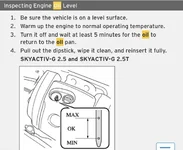- :
- Plano, Texas, USA
And you have a 2.5T? For the 2.5L, see hot / cold oil level comparison pictures in post #9.FYI, I just did a cold check on my 2020 after sitting for 24 hours. It read half way between the full and and low marks. Then I drove it 8 miles and rechecked after a few minutes. It read just a tad below the full mark, around a 1/16" - 1/8" below.

